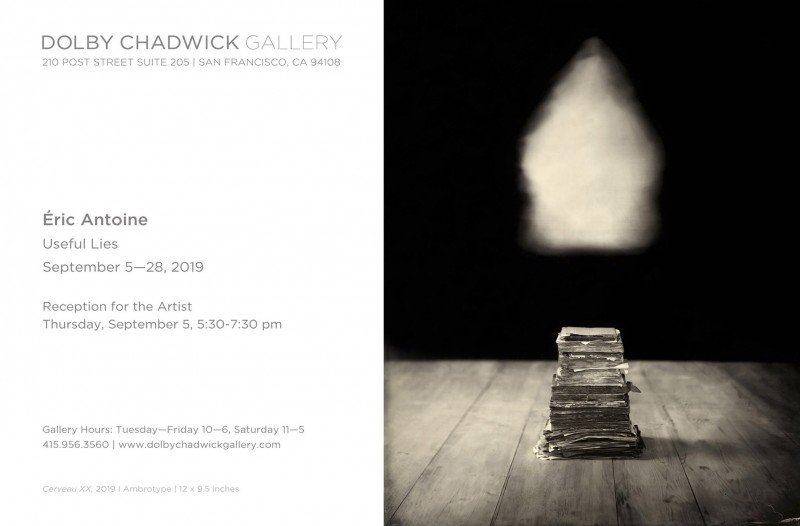
Dolby Chadwick Gallery is pleased to announce Useful Lies, an exhibition of recent work by the French artist Éric Antoine. Antoine works in series, repeatedly photographing the same subjects while experimenting with light, reflection, and composition. As part of his near-obsessive approach, he typically first creates drawings that allow him to closely consider different nuances and possibilities before making the actual photograph. These quiet and at times somber—but always sublime—images are reservoirs of feeling and symbolism that are usually set in and around his home, located in the forest of northeastern France. He is uninterested, he explains, in finding and documenting the exotic, the strange, or the new. His art is instead an intimate and highly personal project, one that is impossible to separate from his life.
Known as wet-plate collodion, Antoine’s photographic process is slow and complicated, and contributes to the already time-consuming nature of his practice. Although he makes prints as well, many of his final works are ambrotypes, which are underexposed glass negatives that appear as positives when the light is stopped by a black background. These are one-of-a-kind objects poised at the cusp of image and sculpture. They also carry with them a long history, having been invented over 150 years ago, shortly after the birth of the photographic medium. Antoine’s work consequently has a unique patina that heightens the mood he sets in motion through his artistic choices, from lens to framing to subject matter. In addition to their silvery quality, which catches the light as you tilt the plate, the ambrotypes exhibit vignetting, bokeh and blurring, drip marks, circumscribed areas of unreadability, and dramatic contrasts between light and dark.
The collodion process also helps visually convey the feeling of being caught between two forces: the drive toward perfection and the desire to embrace flaws. More specifically, Antoine is drawn both to German New Objectivity of the 1920s, with its rejection of Expressionism, and to the movement known as pictorialism. His medium dovetails with his interest in New Objectivity by allowing for great precision and very fine detail. At the same time, the process is highly pictorial in that the artist essentially paints the glass plate with a sensitive coating, which pools and drips and must be controlled. This tension between exactitude and imperfection opens up the works, creating scenes that are both true to nature and evocative of their own realities.
By using an older form of technology, Antoine strips away modern-day conceits in the quest for simplicity, solitude, and core truths. The works speak to the passage of time but also to a sense of timelessness. Aside from a single cardboard box in Les Intrus—a series that highlights the human body and the fragility of shelter—nothing in the photographs dates them. And yet, his framing and cropping are entirely modern, subverting any suggestion of nostalgia. These are not attempts to replicate nineteenth-century photographs but rather forays into unchartered territory that use the past to draft new stories.
The exhibition takes its title from the series of the same name. Useful Lies is notable, Antoine explains, as it is his first wholly optimistic body of work. This optimism is symbolized by a large, almost luminescent white ball, which he situates at the edge of a rocky ledge, on the bank of a rushing stream, under a vaulted canopy of trees, and in a quiet corner of his home, among other places. Some of the most optimistic people, Antoine imagines, live lives that are fraught with agony and hardship, and yet somehow they find this hopefulness that helps them keep going. Often such perseverance can only be achieved by way of what he calls “useful lies,” which we tell ourselves so as to save ourselves. The ball is this useful lie—this optimism that we carry around in the face of pain.
The white ball sits in stark contrast to the smaller black ball, which appears in series such as Les Cerveaux and symbolizes something darker and burdensome, even adverse. Les Cerveaux features piles of books and sheets of papers, both Antoine’s own and those collected over the years from his parents and grandparents. Every leaf represents an individual memory, a single layer in a multifaceted life, and each connective element is a link between those two memories; taken together, they form a complete system. In French, les cerveaux means “the brains.” Different elements are integrated into or positioned around each pile, including the aforementioned black ball, various geometric curiosities, keys, human hands and torsos, sand, sediment, and rocks. Some are classical symbols while others are fashioned by Antoine in service of his own order of meaning, which sometimes extends to encompass subtle social commentary. All of his choices make room for the telling of a thousand stories. In the beautiful, provocative series Drowning Flowers, for example, cut flowers submerged upside down in glass bottles signify ruined youth. But if you scratch the surface, countless other plotlines and histories come tumbling out.
Some of the most captivating stories are authored by the protagonists of The Olive Trees series. Cinema is an important reference for the artist, who notes that the olive trees of his photographs are reminiscent of those dark yet enchanted forests from the films of our childhood, in which the trees can look at you and talk. Antoine’s trees are very humanlike, with twisting trunks, expressive limbs, and deep scars. It should be noted that scars, both visible and invisible, play a prominent role in his work. In this series, they suggest recovery and rebirth, growing along with the tree, which in turn generates new wood to heal the injured area. Such parallels to human life are also underlined by Antoine’s decision to take the photographs as portraits, as if the trees were people. He focuses on their root systems so that the landscape in the background blurs and seems to swirl around their bodies, creating a vortex that further frames his subjects and emphasizes their singular energy.